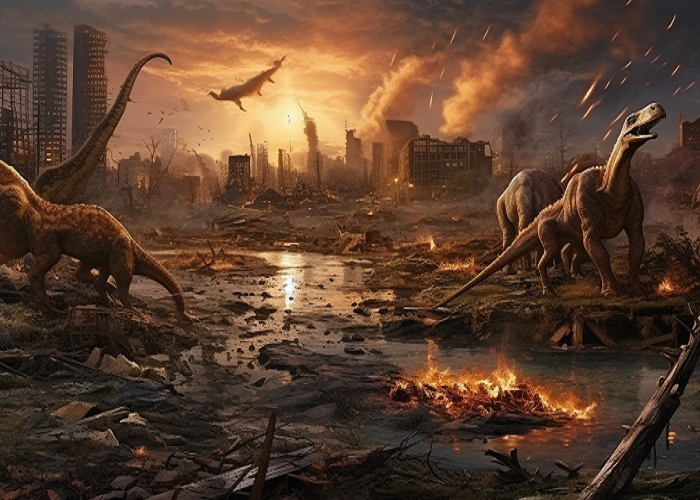The real reason for global warning
1 Definition
Global warming
is a worldwide phenomenon of climate change characterized by a general increase
in average temperatures, mainly attributed to human activities, leading to
lasting alterations in weather patterns and ecosystems.
When we talk
about global warming today, it refers to the rise in temperatures occurring on
Earth over the past approximately 100 to 150 years. Since the beginning of the
industrial revolution, average temperatures at the Earth's surface have been
increasing more or less steadily. In 2016, the planet's average temperature was
about 1 to 1.5 degrees Celsius higher than pre-industrial era averages (before
1800).
2 The Real Consequences of Global Warming


Due to global
warming, many species, both animal and plant, are moving towards cooler
regions. We are also witnessing a significant increase in the number and
intensity of cyclones, earthquakes, and hurricanes, along with record-breaking
heat and climatic instability. Agricultural yields are decreasing substantially,
leading to food shortages, increased droughts, floods, and resulting in more than
30 million climate refugees.
Moreover,
numerous territories located less than a meter above sea level are being
engulfed. There is a risk of mass extinction of species, with 70% of species
facing the threat of extinction, including humans. Additionally, we are
encountering a resurgence of diseases, including viral diseases, which are
linked to the decline in geomagnetism, such as the coronavirus and other viral
illnesses. Furthermore, we have to deal with thermodynamic diseases and
pandemics.
3 The Real
Causes of Global Warming


External natural factors to the climate system, such as changes in volcanic activity, solar energy emission, and the Earth's orbit around the Sun, can modify the planet's climate. Among these factors, the two most significant at the time scale for contemporary climate change are changes in volcanic activity and variations in solar radiation. These factors mainly influence the amount of energy received by the Earth in its energy balance. Volcanic eruptions have a relatively short-term impact on climate. Variations in solar irradiation have contributed to climate trends over the last century, but since the industrial revolution, the effect of greenhouse gas emissions in the atmosphere has been approximately 50 times more significant than changes in solar energy emission.
Our planet Earth's greenhouse effect began to be disturbed by the decrease in geomagnetism and human and military industrial activities (nuclear tests, nuclear weapons, missiles, explosives), which led to geodynamic, geomagnetic, and thermodynamic disturbances since around 1750.
The Sun's rays provide energy to the Earth. Consequently, a portion of this energy is directly or indirectly reflected back into space, while the majority is absorbed by the atmosphere or the Earth's surface. The relatively mild temperature at the Earth's surface is due to gravity and thermodynamic greenhouse gases, which redirect a significant portion of surface radiation back towards the ground, as well as other thermodynamic sources.
Naturally, there is a greenhouse effect where CO2 and other greenhouse gases allow a significant part of the solar radiation to pass through but trap the infrared radiation that is re-emitted. This radiation is trapped by greenhouse gases (GHGs) and clouds, leading to an increase in temperature.
Moreover, the Earth's magnetic field acts as a shield against magnetic fields present in space and in the Earth's crust and mantle. It originates from the outer core through a self-excitation mechanism called the dynamo. Of course, life on Earth is made possible by the presence of solar energy, but paradoxically, this same energy also has the potential to eliminate the life it has created. Our Sun constantly emits solar wind through thermodynamic effect. Without protection, this deadly wind would pass through our bodies and damage our DNA, causing deadly diseases. Currently, we are witnessing a disruption and a decrease in the Earth's geomagnetism. As a result, the Earth's magnetic shield is weakening, which is the primary reason for current global warming.
We are
currently observing a decrease in geomagnetism, and this decrease began two
centuries ago. It will span over a period of 1000 years to lead to a
thermodynamic inversion of the Earth's magnetic poles. The inversion of
magnetic poles is an irreversible process as it is linked to the Earth's
thermodynamic activity.
4 The Real
Reason for Global Warming


We all bathe in the Earth's magnetic field without even realizing it. We become particularly aware of it when we need to navigate using a compass. This is the most evident manifestation of the existence of the Earth's magnetism, which has been present since the creation of the universe and is generated, 3000 kilometers beneath our feet, by the motion of the Earth's liquid iron core. Due to the presence of this liquid iron (which turns into a solid core at a depth of 5000 km), it behaves like a gigantic magnet with well-organized field lines currently forming a dipole, with a north and a south magnetic pole oriented more or less along the Earth's rotational axis. Currently, we are witnessing a decrease in geomagnetism, which began two centuries ago, and it will extend over 1000 years to complete a thermodynamic inversion of the Earth's magnetic poles. The magnetic pole reversal is currently an irreversible process as it is a thermodynamic activity.
The mid-term
consequences will be cyclones, an increase in cyclones, earthquakes, and violent
volcanic activity. In the long term, starting from the year 2400, there will be
instability of the Earth's geostationary orbit due to the decrease in
geomagnetism and the thermodynamic and gravitational influence of the planets
Jupiter and Saturn, followed by an ice age. From the year 2550, when the
magnetic inversion of the Earth is completed, by the year 2900, the Earth's
orbit will stabilize, and there will be changes in thermodynamic conditions.
There will be a large amount of oxygen. The Earth's atmosphere near the
completion of the magnetic inversion in 2900 will have at least 35% oxygen,
leading to the presence of much larger species than contemporary ones.
Currently, the air contains 21% oxygen.
5 The Extinction of Dinosaurs and Terrestrial Thermodynamics


